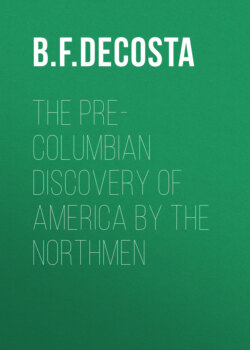Читать книгу The Pre-Columbian Discovery of America by the Northmen - B. F. DeCosta - Страница 9
На сайте Литреса книга снята с продажи.
JUBA'S EXPEDITION.
ОглавлениеWhen King Juba II returned to Mauritania, he sent an expedition to the Fortunate Isles. A fragment of the narratives of this expedition still survives in the works of Pliny. They are described as lying southwest, six hundred and twenty-five miles from Purpurariæ. To reach them from this place, they first sailed two hundred and fifty miles westward and then three hundred and seventy-five miles eastward. Pliny says: "The first is called Ombrios, and contains no traces of buildings. There is in it a pool in the midst of mountains, and trees like ferules, from which water may be pressed, which is bitter from the black kinds, but from the light kinds pleasant to drink. The second is called Junonia, and contains a small temple built entirely of stone. Near it is another smaller island having the same name. Then comes Capraria, which is full of large lizards. Within sight of these is Nivaria, so called from the snow and fogs with which it is always covered. Not far from Nivaria is Canaria, so called on account of the great number of large dogs therein, two of which were brought to King Juba. There were traces of buildings in these islands. All the islands abound in apples, and in birds of every kind, and in palms covered with dates, and in the pine nut. There is also plenty of fish. The papyrus grows there, and the silurus fish is found in the rivers."[8] The author of Prince Henry the Navigator,[9] says that in Ombrios, we recognize the Pluvialia of Sebosus. Convallis of Sebosus, in Pliny, becomes Nivaria, the Peak of Teneriffe, which lifts itself up to the majestic height of nine thousand feet, its snow-capped pinnacle seeming to pierce the sky. Planaria is displaced by Canaria, which term first applied to the great central island, now gives the name to the whole group. Ombrios or Pluvialia, evidently means the island of Palma, which had "a pool in the midst of mountains," now represented by the crater of an extinct volcano. This the sailors of King Juba evidently saw. Major says: "The distance of this island [Palma] from Fuerteventura, agrees with that of the two hundred and fifty miles indicated by Juba's navigators as existing between Ombrios and the Purpurariæ. It has already been seen that the latter agree with Lancerote and Fuerteventura, in respect of their distance from the continent and from each other, as described by Plutarch. That the Purpurariæ are not, as M. Bory de St. Vincent supposed, the Madeira group, is not only shown by the want of inhabitants in the latter, but by the orchil, which supplies the purple dye, being derived from and sought for especially from the Canaries, and not from the Madeira group, although it is to be found there. Junonia," he continues, "the nearest to Ombrios, will be Gomera. It may be presumed that the temple found therein, was, like the island, dedicated to Juno. Capraria, which implies the island of goats, agrees correctly with the island of Ferro, ... for these animals were found there in large numbers when the island was invaded by Jean de Bethencourt, in 1402. But a yet more striking proof of the identity of this island with Capraria, is the account of the great number of lizards found therein. Bethencourt's chaplains, describing their visit to the islands, in 1402, state: 'There are lizards in it as big as cats, but they are harmless, although very hideous to look at.'"[10]
We see, then, that the navigators of Juba visited the Canaries[11] at an early period, as Strabo testifies was the case with the Phenicians, who doubtless built the temple in the island of Junonia. And, for aught we know, early navigators may have passed over to the Western continent and laid the foundation of those strange nations whose monuments still remain. Both Phenician and Tyrian voyages to the Western Continent, have been warmly advocated; while Lord Kingsborough published his magnificent volumes on the Mexican Antiquities, to show that the Jews settled this continent at an early day.[12] And if it is true that all the tribes of the earth sprang from one central Asiatic family, it is more than likely that the original inhabitants of the American continent crossed the Atlantic, instead of piercing the frozen regions of the north, and coming in by the way of Behring Straits. From the Canaries to the coast of Florida, it is a short voyage, and the bold sailors of the Mediterranean, after touching at the Canaries, need only spread their sails before the steady-breathing monsoon, to find themselves wafted safely to the western shore.
